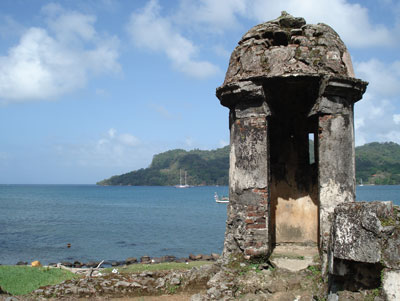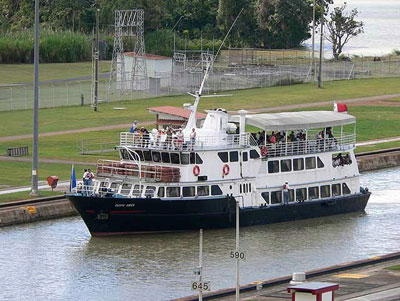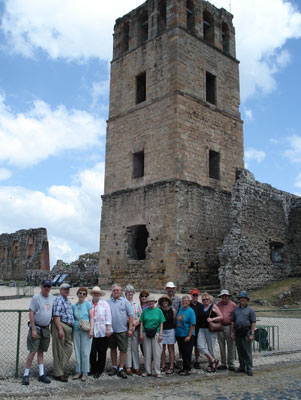Exploring Panama by land, plus a canal crossing
by Jerry Gordon, Riverside, CA
I was looking through the sale books in an airport bookstore when a nonfiction by one of my favorite writers, David McCullough, caught my eye. In “The Path Between the Seas,” written more than 30 years ago, McCullough tells the story of the Panama Canal from 1870 to 1914.
I had always had an interest in the canal, but, I have to admit, I knew a lot less than I thought I knew.
McCullough is a great storyteller, and the 600 pages passed quickly, fascinating me with the topic to the point that I wanted to see the canal for myself. However, I am not a fan of cruises, so I resigned myself to the idea that it would not happen.
A few months later, as I was reading International Travel News, I discovered a small ad for a company based in Charlotte, North Carolina, called Costa Rica Tours, Ltd. They specialize in small-group tours to both Costa Rica and Panama.
I checked out their website (www.costaricatoursltd.com) and was quite impressed. I was delighted to see that their land tour to Panama included a full transit of the Panama Canal as a day trip, which would fulfill one of my goals.
After much contemplation I called them (704/541-8680) and was surprised when the company owner, Sandra Feldman, answered the phone. I asked my many questions and became more and more interested in her tour to Panama. After a few more phone conversations and comparing this small-group tour to those offered by other companies, I made my decision to travel with Costa Rica Tours on their “Canal Transit Tour,” Jan. 25-30, 2008.
Pretour trip
One of the questions I had for Sandra was whether or not I could take the ocean-to-ocean train, something that was not included in the original itinerary.
The railway was built after 1849 as a safer and easier route across the continent and to speed the mail service from the east coast to the west coast. Only recently had it been restored and put back into operation for both commuters and tourists. Sandra arranged for an add-on tour for the day preceding the main tour, and it eventually attracted eight of the 14 passengers who had signed up for the whole excursion. When adding the cost of the pretour to the regular tour package, the 7-day experience cost $1,650 plus airfare.
The train departed at 7:15 a.m. for the 60-minute ride from Panama City on the Pacific side to Colón on the Atlantic/Caribbean side. Once we were on the Caribbean side, our guide and driver met us at the train station and took us to Portobelo, where we toured the formerly protected port located in a secluded bay about 20 miles from the end of the canal.
We also visited the historic church where Portobelo’s famous Black Christ statue rests. After lunch, we returned to Panama City by van.
The canal
Our group, along with 200 other passengers, transited the Panama Canal on the second day of our tour. We left Panama City at 7:30 a.m. and went through the entire canal in eight hours, returning by motorcoach in 90 minutes.
While on the ship, we were given a history of the canal and a detailed description of what we were seeing. Being on a smaller ship, one gains an awareness of the enormity of the locks, which is lost to passengers on large cruise ships that entirely fill the lock chamber.
Having read McCullough’s book was a wonderful asset in preparation for this tour. Although there was a lot in his volume that I had forgotten, learning more about the dramatic French involvement and their disastrous first attempt to build the canal made the transit more interesting. Also, I previously had not fully appreciated the tenacity of President Theodore Roosevelt. The trip was a terrific reinforcement of the information described in the book.
City sights
The next day, we took a land tour to El Valle de Anton, a town located in the crater of one of the world’s largest extinct volcanoes. It is some 75 miles from Panama City and took about two hours to get there. On the way, we saw the beautiful scenic mountains of rural Panama.
While in El Valle we visited the Sunday market, where we bought local crafts created by Ngöbe Buglé (Guaymí) artisans plus molas (reverse-appliquéd textiles) made by Kuna artisans. We also visited El Níspero Botanical Gardens & Zoo, where we saw unusual tropical flora and fauna, and had a chance to walk in the surrounding rainforest. In town, we had lunch and visited a museum and an art gallery.
The following day was our full-day Panama City tour. As we traveled from one section of the city to the other, we saw many modern skyscrapers, which surprised most of us. We also saw the 16th-century ruins of the original city, now known as Panama La Vieja.
Afterward, we visited Colonial Panama (Casco Viejo), which was built after the destruction of Panama La Vieja. The original was destroyed either by fire or by pirates; we heard both theories. We walked the narrow streets studying the impressive restoration of the buildings.
We also visited the former US Canal Zone to see the Miraflores locks and the informative visitors’ center.
Village visit
On our last day we had a full-day excursion to an Emberá village, which was like a page out of National Geographic. Situated on the banks of the Chagres River in the heart of a tropical rainforest, the village is accessible only by sturdy canoes (with motors).
We met the gentle Emberá villagers, learned about their culture and saw their ceremonial dances.
Many of us purchased woven baskets as well as carved tagua nut figurines made from the hard seeds of the village’s palm trees. The village healer showed us his garden where he raises plants to prepare natural medicines.
In the evening, we had our farewell dinner at a Chinese restaurant in Panama City.
Summing up
All the passengers on the tour were professionals, mostly teachers, who shared with me a desire to learn as much about the area as possible. Their ages ranged from mid-50s to early 70s. They were great to be with, making the experience even better.
Panama is a beautiful country. Although there is poverty, Panama has the highest median income of any country in Central America.
It has become the new “hot” destination both for travelers and relocating retirees from the United States. Between the two groups, they keep the hotel occupancy rate at about 96%.
It is easy to travel in Panama. The US dollar is their paper currency, and the electrical voltage and outlets are the same as ours, so there is no need for a converter. The tap water is safe to drink, and I found the food good, plentiful and inexpensive.
We frequently ate corvina, or Panamanian sea bass, which was prepared in different and interesting ways. We also had delicious tilapia with plantains and fruit in the Emberá village.
Had I not found McCullough’s book on sale, chances are I would not have made this trip. Be careful what you read; you might end up with an incurable urge to travel.





